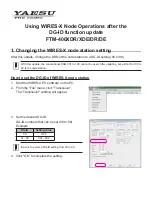
2/8
www.qundis.com Network
Node WTT16 V22
CE1N2874en
09.09.2009
Functions
Reception and storage of the data transmitted by the consumption meters
Automatic creation of a network with up to 12 WT…16 (with a maximum of 500 consump-
tion meters)
Passing on all relevant consumption values to all WT…16 on the network
Communication via the QUNDIS gateway
Communication with the OZW10 M-bus central unit
Network node versions
The WT…16… network node is a component of the Q AMR system and has been designed
for exclusive use with that system.
It is available in a number of versions for different applications:
Application Battery-powered
Mains-powered
Standard
WTT16
WTX16
With RS-232 interface for local data
readout
WTT16.232
WTX16.232
Network nodes with integrated gateway are used for the remote readout of Q AMR net-
works. They are described in data sheet CE1J2878.
Combinations
All network nodes with integrated gateway can be used along with any other network node.
The maximum number of 12 network nodes in one system must not be exceeded.
The network nodes with gateway and integrated M-Bus master (WTX16.GSM and
WTX16.IP) are able to read M-Bus meters according to EN13757-2/3
Technical design
The network node consists of the following subassemblies:
tr
an
sc
ei
ve
r f
or
Q AMR n
etwor
k
memory for
500 meters
M-Bus
(Slave)
RS232
(optional)
backup battery
power supply:
mains supply WTX16..
battery WTT16...
Receiver and transmitter are used for receiv-
ing consumption data and forwarding them to
other network nodes of the network. The
memory stores the consumption data. It is
protected against temporary power drops (e.g.
mains power failure or replacement of the
main battery) by a backup battery. The net-
work can be read locally via the M-Bus inter-
face. The network nodes WT..16.232 have an
additional RS232 interface for readout pur-
poses.
WTT16.. nodes are battery-operated, while WTX16.. require a mains power supply AC 100V
.. 230 V.
The network node consists of 2 major sections: The base and the housing with the electron-
ics. It is thus possible to mount the base prior to commissioning, enabling the electrical in-
staller to connect the WTX16 to the mains network. At the time of commissioning, the elec-
tronics section is snapped on and the electrical connections are made.
The housing with the electronics is identical for all types of network nodes. It contains the
network controls:
Basic design
Electronics section


























